Abstract
Objective:
When given to children for 1 year after a severe burn, oxandrolone significantly improves lean body mass, bone mineral content, and muscle strength. The beneficial effects of oxandrolone on height and weight were observed 1 year after treatment was discontinued. To study the efficacy of oxandrolone in severely burned children for 12 months after burn and 12 months after the drug was discontinued.
Summary Background Data:
Oxandrolone attenuates body catabolism during the acute phase after burn. It is unclear whether oxandrolone would have any beneficial effects during long-term treatment or if there were any effects after the drug was stopped.
Methods:
Sixty-one children with 40% total body surface area burns were enrolled in this study. Patients were randomized into those to receive oxandrolone (n = 30) or placebo (n = 31) for the first 12 months. Treatment was discontinued after 12 months, and the patients were studied without the drug for the following 12 months. At discharge and 6, 12, 18, and 24 months after burn, height, weight, body composition, resting energy expenditure, muscle strength, and serum human growth hormone, insulin-like growth factor-I (IGF-1), IGF binding protein-3, insulin, cortisol, parathyroid hormone, tri-iodothyronine uptake (T3 uptake), and free thyroxine index (FTI) were measured. Statistical analysis used Tukey multiple comparison test. Significance was accepted at P < 0.05.
Results:
Oxandrolone improved lean body mass, bone mineral content and muscle strength compared with controls during treatment, P < 0.05. Serum IGF-1, T3 uptake, and FTI were significantly higher during drug treatment compared with controls, P < 0.05. Significant increases in height and weight with oxandrolone were observed after the end of treatment.
Conclusions:
Oxandrolone improved body composition and strength in severely burned children during the 12 months of treatment. Its effect on height and weight continued after treatment was discontinued.
Oxandrolone, when given to children for 1 year after a severe burn, significantly improves lean body mass, bone mineral content, and muscle strength. The beneficial effects of oxandrolone on height and weight were observed 1 year after treatment was discontinued.
Severe burns represent a major physical and psychologic event in a child's life. Progress in the treatment of burns, such as fluid resuscitation, early burn wound excision, new antibiotics, and nutritional support has reduced burn mortality.1 A major determination of morbidity in burn patients is the extent and duration of the hypermetabolic and catabolic response to injury. These responses are characterized by tachycardia, increased resting energy expenditure, peripheral insulin resistance, fat and protein catabolism, and muscle and bone wasting, which last for 1 to 2 years after burn and lead to growth retardation.1,2 These posttraumatic responses delay recovery, rehabilitation, and social and psychologic integration back into society.3–6 Various therapeutic approaches have been introduced to ameliorate these adverse effects.7,8 We and others have hypothesized that the use of anabolic agents may attenuate the posttraumatic response and improve long-term outcomes.1,8
Oxandrolone, a synthetic analog of testosterone with minimal virilizing activity and liver toxicity, attenuates muscle wasting after severe trauma, malnutrition, or acquired immunodeficiency virus.9,10 In severely burned children treated during acute hospitalization, oxandrolone significantly improved net protein synthesis, lean body mass, bone mineral content, synthesis of the hepatic constitutive proteins such as albumin and prealbumin, and attenuated the acute phase reactive protein levels.11–13 The aim of this study was to determine whether oxandrolone, administered for 1 year after injury to severely burned children, would attenuate catabolism and growth arrest and whether these positive attributes would persist after the drug is discontinued.
METHODS
Subjects
Sixty-one severely burned children were enrolled between 1998 and 2004 in a study to test the efficacy of oxandrolone in the first year after burn and for 1 year after oxandrolone was discontinued. Inclusion criteria were: age ≤18 years, total body surface area burns of ≥40%, and availability for studies at discharge, 6, 12, 18, and 24 months after burn. This study was approved by the Institutional Review Board at the University of Texas Medical Branch. Informed written consent was obtained from each patient's guardian with the assent of the child prior to enrollment.
Patients were randomized in a double-blinded study to take 0.1 mg/kg oxandrolone (BTG Pharmaceuticals, Iselin, NJ) or placebo orally twice daily for 12 months after burn from the date of hospital discharge. Guardians and patients were instructed and supervised in the proper use of the drug. Patients were studied at discharge (1 to 2 months after burn), and at 6, 12, 18, and 24 months after injury (Fig. 1). At the time of hospital admission and follow-up, patients where examined by physicians, including a pediatric endocrinologist, and reviewed by a pediatric safety committee to screen for compliance and adverse side effects such as hirsutism, virilization in females, and precocious pubertal development in males. Tanner scores were recorded and hand and knee x-rays were taken of each subject at each follow-up period to evaluate for possible premature closure of epiphyseal plates induced by anabolic agents.
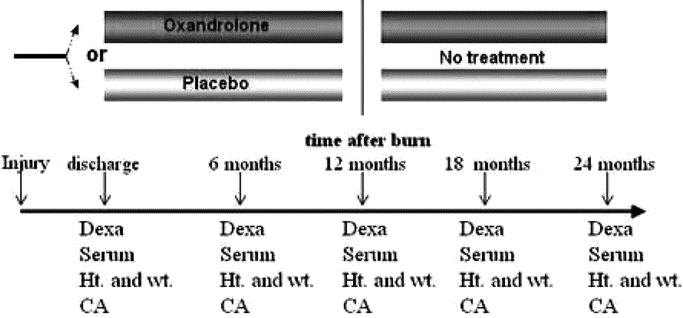
FIGURE 1. Schematic of study protocol for Dexa, height and weight, serum (hormone analysis), and clinical assessment (CA) measures. Clinical assessments include physical examinations and screening for adverse side effects, which are evaluated by a committee of 5 clinical experts to decide whether the treatment should be discontinued.
Body Composition
Body heights and weights were measured and percentiles for age and gender were calculated. The percent change in the ratio of the number of patients above the 25th percentile, for height or weight, to the total when compared with the discharge ratio at each time interval was calculated for oxandrolone and placebo. Total lean body mass (LBM), fat, and bone mineral content (BMC) were measured by dual energy x-ray absorptiometry (Hologic model QDR-4500W, Hologic, Inc., Waltham, MA). To minimize systematic deviations, the Hologic system was calibrated daily against a spinal phantom in the anteroposterior, lateral, and single-beam modes. Individual pixels were calibrated against a tissue bar phantom to determine whether the pixel was reading bone, fat, lean tissue, or air.
Scar Assessment
Scars were evaluated clinically using the Vancouver Scar Scale.8
Hormone Panel
Whole blood was withdrawn to determine serum human growth hormone (hGH), insulin-like growth factor-I (IGF-I), IGF binding protein-3 (IGFBP-3), insulin, cortisol, total thyroxine (total T4), tri-iodothyronine uptake (T3 uptake), and free thyroxine index (FTI). All were measured using enzyme-linked immunosorbent assays from Diagnostic Systems Laboratory (Webster, TX). Testosterone was measured by high-pressure liquid chromatography (Beckmann System Gold Nouveau). Samples and standards were diluted and loaded on Oasis cartridges. Samples and standards were eluted, washed, and loaded on the high-pressure liquid chromatography column (range of linearity, 10–1000 ng/ml; limit of detection, 4 ng/ml; limit of quantitation, 10 ng/ml; sample recovery range; 87–103%).
Indirect Calorimetry
Resting energy expenditure (REE) was measured using a Sensor-Medics Vmax 29 metabolic cart (Yorba Linda, CA). Composition of inspired and expired gases were sampled and analyzed at 60-sec intervals. Values during a 5-min steady state were accepted. The average REE was calculated from steady state measurements.
Strength Measurements
Strength testing was conducted on children age ≥7 years using a Biodex System-3 dynamometer (Shirley, NY) as previously described.14 The isokinetic test was performed on the dominant leg extensors and tested at an angular velocity of 150°/sec. This speed was chosen because it was well tolerated (compared with lower or higher angular speeds) by the children across all ages and all groups. The patients were seated and their position stabilized with a restraining strap over the midthigh, pelvis, and trunk in accordance to the Biodex System-3 Operator's Manual. All patients were familiarized with the Biodex test in a similar manner. The administrator of the test demonstrated the procedure, then the test procedure was explained to patients and the patients were allowed to practice the actual movement during 3 submaximal repetitions without load as warm-up. More repetitions were not allowed to prevent the onset of fatigue. The anatomic axis of the knee joint was aligned with the mechanical axis of the dynamometer before the test. After the 3 submaximal warm-up repetitions, 10 maximal voluntary muscle contractions (full extension and flexion) were performed. The maximal repetitions were performed consecutively without rest in between. Three minutes of rest were given to minimize the effects of fatigue before the test was repeated.
Values of peak torque were calculated by the Biodex software system. The highest peak torque measurement between the 2 trials was selected. Peak torque was corrected for gravitational moments of the lower leg and the lever arm.
Statistical Analysis
Data are presented as mean ± standard error of the mean. Statistical analysis was performed using Tukey multiple comparison test, with significance accepted at P < 0.05. Changes in height and weight percentiles were compared using Fisher exact test. Statistical software (SigmaStat and SigmaPlot, SPSS, Chicago, IL) was used for analyses.
RESULTS
Demographics
Sixty-one patients were randomized to receive oxandrolone (n = 30) or placebo (n = 31). There were no significant differences in age, gender, socioeconomic status, and burn size between the groups (Table 1). One patient in the oxandrolone group was white and 29 patients were Hispanic. In the placebo group, 5 patients were white and 26 patients were Hispanic. Caloric intake and exercise levels were obtained and there was no significant difference between groups. Six patients in the placebo group and 3 patients in the oxandrolone group were dropped from the study because of missed follow-up appointments. Three patients in the oxandrolone group were excluded due to side effects.
TABLE 1. Patient Demographics
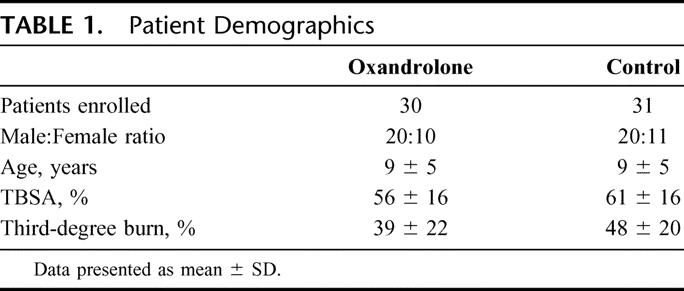
Body Composition
Percent changes in the number of patients in the percentiles above the 25th percentile for height and weight were significantly increased with oxandrolone compared with discharge at 18 months and 24 months after burn respectively, P< 0.05 (Figs. 2 and 3). Percent changes in LBM were significantly higher at 12 months after burn in the oxandrolone group when compared with placebo (P < 0.05) (Fig. 4). The effect of oxandrolone on BMC compared with placebo was significant at 12 months after burn (Fig. 5). There were no significant differences between oxandrolone and control at 18 and 24 months.
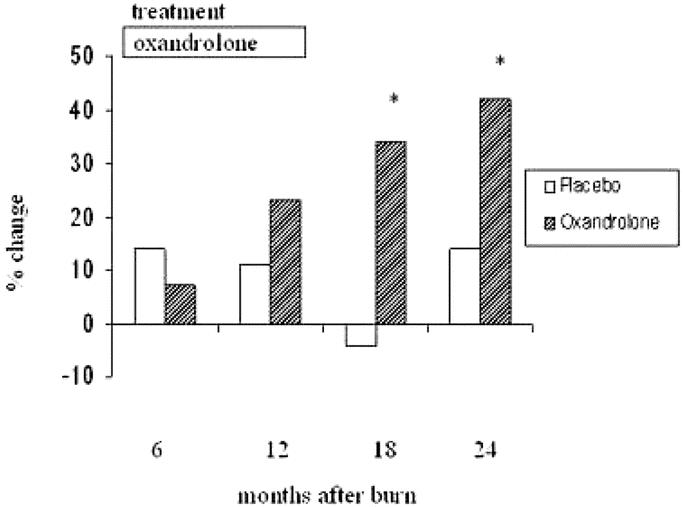
FIGURE 2. Percent change with time in the number of burned children in the greater than 25th percentile/total for height when compared with values obtained at hospital discharge. *Significant changes in height were observed 6–12 months after oxandrolone was discontinued, P < 0.05.

FIGURE 3. Percent change with time in the number of burned children in the greater than 25th percentile/total for weight when compared with values obtained at hospital discharge. *Significant changes in weight were observed 12 months after oxandrolone was discontinued, P < 0.05.

FIGURE 4. Percent change in lean body mass from discharge to 24 months after burn. Values are means ± SEM. *Significant difference between oxandrolone and placebo, P < 0.05.
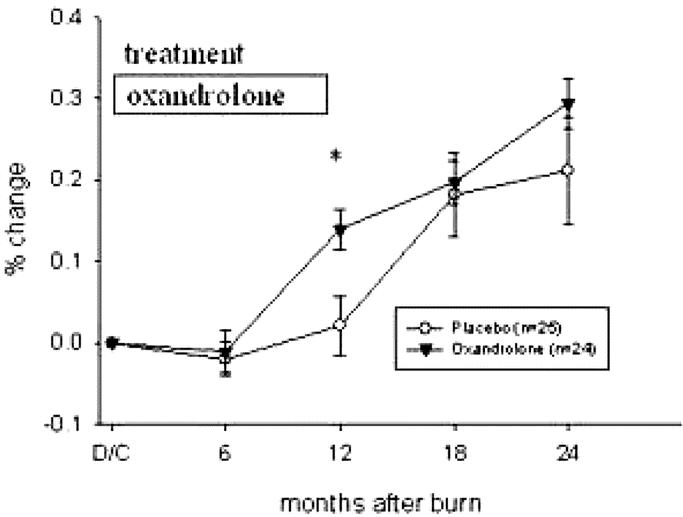
FIGURE 5. Percent change in bone mineral content when measured by Dual Energy x-ray analysis. Values are mean ± SEM. *Significant difference between oxandrolone and placebo, P < 0.05.
Scar Assessment
No significant difference in scar assessments between oxandrolone and placebo could be shown.
Indirect Calorimetry
There was no significant difference between oxandrolone and placebo for the percent of predicted REE.
Hormone Panel
Oxandrolone significantly increased serum IGF-1, T3 uptake and FTI (P < 0.05). Insulin-like growth factor-1 was significantly higher at 12 and 18 months (Fig. 6), whereas T3 uptake was significantly higher at 6 months after burn (Fig. 7). Cortisol, insulin, GH, IGFBP-3, and parathyroid hormone were not significantly changed by oxandrolone (Table 2). Testosterone levels were not significantly different between oxandrolone and placebo.
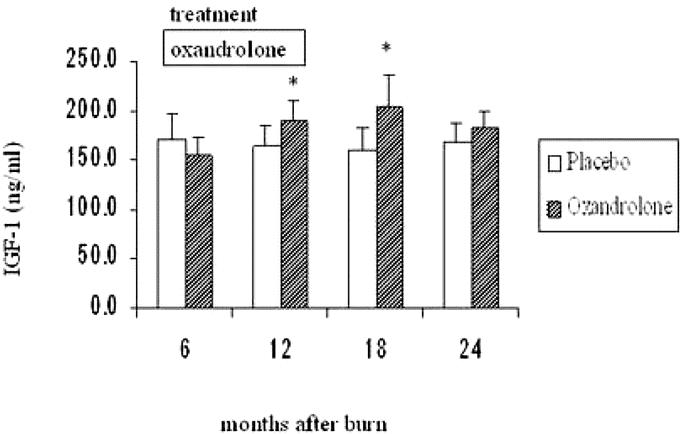
FIGURE 6. Serum concentrations of insulin-like growth factor-1 with time after burn. Values are mean ± SEM. *Significant difference between oxandrolone and placebo, P < 0.05.
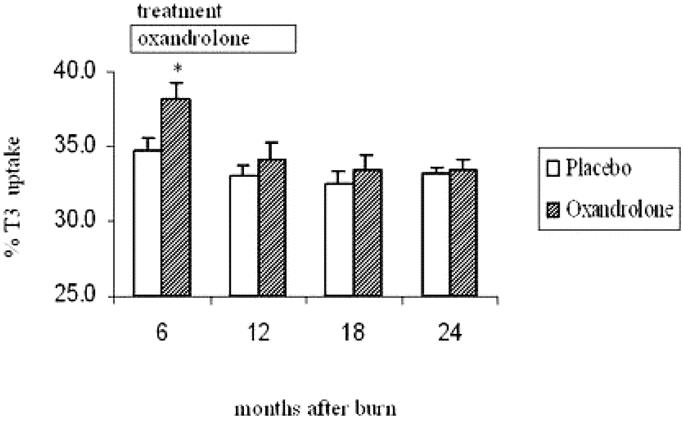
FIGURE 7. Effects of oxandrolone on percent uptake of tri-iodothyronine (T3 uptake) with time. Values are mean ± SEM. *Significant difference in T3 uptake between oxandrolone and placebo at 6 months after burn, P < 0.05.
TABLE 2. Hormones Studied
Strength Measurements
Strength measures significantly improved with oxandrolone at 12 months after burn compared with those receiving placebo (Fig. 8). There was no significant continuing effect on leg strength once the drug was discontinued.
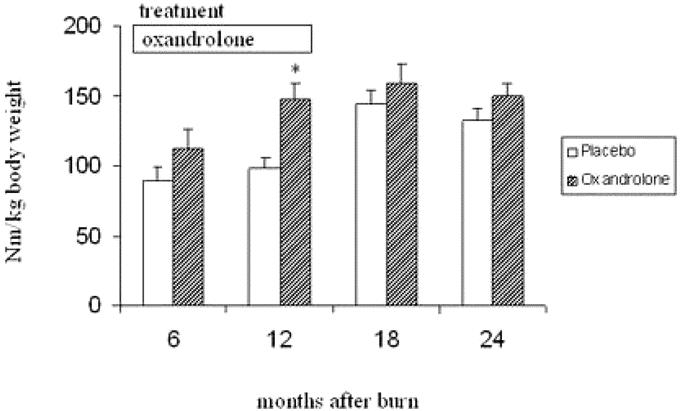
FIGURE 8. Muscle strength was significantly improved with oxandrolone 12 months after burn. Normal values for healthy children: 182 Nm/kg body weight (SD 40). Data are presented as mean ± SEM. *Significant difference between oxandrolone and placebo at P < 0.05.
Bone Age
No difference between chronological age and bone age could be demonstrated for oxandrolone- or placebo-treated children with no evidence of a premature closure of ephiphyseal plates.
Side Effects
Three female patients with perineal burns developed edema of the skin overlying the clitoris. After the drug was stopped, this condition was resolved. There was no hypertrophy of the corpora, but the skin forming the clitoral hood was redundant. These side effects were not seen in the placebo group. No other side effects such as hepatotoxicity occurred during the study period.
DISCUSSION
Improvements in acute burn care, which have significantly reduced mortality, include early burn wound excision and grafting, fluid resuscitation, infection control, and enteral nutrition.1,15 With improved survival, the clinical challenge is how to improve long-term outcomes in severely burned children. Long-term recovery from massive trauma is often determined by the catabolic effects of hypermetabolism leading to muscle breakdown and a negative net nitrogen balance in skeletal muscle.16,17 This posttraumatic stress response can persist up to 24 months after burn, with loss of muscle mass, strength, growth, and an increase in resting energy expenditure, which significantly delays recovery and reintegration back into society.2,4,5,18
In the current study, we continued our investigation of the metabolic effects of a severe thermal injury for 2 years after injury. Our data indicate that oxandrolone significantly improves LBM, BMC, and strength during treatment, which demonstrates that improved body composition is associated with an increase in function or strength. These effects were seen only during the treatment period, whereas changes in height and weight percentiles for age and gender were significantly improved after the treatment was discontinued. Since bone age proceeded in parallel with chronological age in both groups, the improvements in height in oxandrolone-treated children may be permanent.
In addition to body composition, serum IGF-1, T3 uptake, and FTI were significantly elevated with oxandrolone. These hormones, especially IGF-1 and the thyroid hormones, promote protein synthesis and have an anabolic effect on body composition and growth.19–21 Despite increased IGF-1 concentrations, oxandrolone did not affect growth hormone levels. The observation of elevated IGF-1 concentrations during the treatment and after the drug was discontinued could be explained by the improved muscle mass in the oxandrolone group at 12 months. Recent findings suggest an expression of IGF-1 depending on muscle mass and strength, and not by the liver after GH stimulation.22 The cause of significantly higher IGF-1 levels and the increased muscle mass during treatment in the oxandrolone group may explain the delayed effects on height and weight.
These beneficial effects on body composition, strength, and hormone metabolism are most likely related to oxandrolone treatment since there are no significant differences between the treatment and placebo groups regarding age, gender, ethnicity, socioeconomic status, and burn size (see also discussion by Dr. Herndon).
Oxandrolone itself acts directly on tissue via the androgen receptor and by activating down-stream molecules such as nuclear factor kappa β in liver, muscle, fat, and bone.23,24 Stable isotope infusion studies during the acute phase after burn in pediatric patients receiving oxandrolone at our institution showed a significant increase in protein synthetic efficiency, with no change in protein breakdown.11
Three female patients with perineal burns developed edema of the skin overlying the clitoris. After the drug was stopped, this condition was resolved. No other side effects (e.g., hepatotoxicity, early closure of growth plates, or negative effects on pubertal development) were observed. Nevertheless, we strongly recommend close follow-up of patients treated with oxandrolone until puberty is reached. In addition to the advantage of having few side effects, oxandrolone is cost-effective. A daily dose costs about $3. Furthermore, giving oxandrolone orally in the form as a tablet is safe and easy to administer and is, therefore, an optimal outpatient treatment.
Oxandrolone was shown to successfully attenuate burn induced muscle and bone catabolism and significantly improved muscle strength without accelerating epiphyseal closure. Further, oxandrolone continued to significantly improve height and weight after it was discontinued.
We conclude that the benefits of extended use of oxandrolone, for as long as 2 years after injury, should be considered in severely burned children.
ACKNOWLEDGMENTS
The authors want to thank D. Benjamin, W. Benjamin, K. Cantu, M. Celis, J. Huddleston, M. Kelly, G. Kulp, J. Martinez, and S. Ojeda for their technical assistance.
Discussions
Dr. Basil A. Pruitt, Jr. (San Antonio, Texas): Dr. Herndon and his colleagues have added a new chapter to their impressive volume of studies that have enlightened previous meetings of this Association by describing the neurohormonal response to the injury itself and the treatment applied in patients with extensive burns. This excellent study emphasizes that at present, when survival of patients with burns involving up to 85–90% of the total body surface is commonplace, other outcomes such as rapidity of reconstitution of lean body mass, restoration of physical function and, as in the children described this morning, resumption in height and weight gain must be considered. The findings provide evidence that convalescence can be accelerated and functional recovery enhanced by hormonal supplementation and manipulation.
We do need additional information to help us assess the conclusions offered this morning. In addition to the variables mentioned, there are other factors that can influence bone mineral density, height, weight, and lean body mass. Three obvious factors are caloric intake, diet composition, and physical exercise and activity. How were those variables monitored? Did the patients keep a nutritional diary and were physical activity and exercise controlled or at least recorded to assess comparability?
Since skeletal growth occurs in spurts, did the oxandrolone alter the frequency, duration, or intensity of such growth spurts? Since 6 patients from each group were dropped or excluded from the study, should the percentage of patients in the greater than 25th percentiles of height and weight changes shown in Figures 2 and 3 be recalculated on the basis of intent to treat? If you did that, would the significance of the observed differences be maintained?
There appeared to be a correlation between oxandrolone treatment and thyroid function as represented by T3 update and free thyroxine index. In our early studies at the Army Burn Center we observed an inverse relationship between circulating catecholamine levels and thyroid function, and I wonder whether you measured the catecholamine levels in your study patients and whether the oxandrolone effect is a consequence of a reduction in catecholamine production? Such an effect might be reflected by a decrease in resting energy expenditure in the oxandrolone treated patients. Did you measure metabolic rate in these patients and was it systematically lower in the oxandrolone group?
I compliment the authors on their fine work which demonstrates that it is indeed possible to beneficially affect long-term outcomes in severely burned children without inducing significant side effects.
Dr. David N. Herndon (Galveston, Texas): In regards to physical activity and nutrition, dietary histories were taken and forms filled out weekly. For the first 3 months of treatment these patients were kept in an environment and drug administration was ordered as well as caloric intake and exercise diaries were obtained and reobtained at 3-month intervals thereafter. There was no difference between groups. But this is truly an important effector of growth overall and a larger series will have to be performed to monitor dietary and activity effects.
Skeletal spurts are indeed important in growth, and a larger number of individuals already enrolled into this study will have to be analyzed to see which periods skeletal growth are affected or not affected by this treatment. Overall with an intent to treat design in this small number of individuals significance is preserved, but larger numbers will have to be studied to segregate gender effects and to segregate effects at different times of skeletal growth in patients.
The catecholamine levels and resting energy expenditure levels were not significantly different between the 2 groups over the 2 year study period, but again a larger series may be able to define the relationship that you previously defined in acutely injured individuals.
Dr. Richard L. Gamelli (Maywood, Illinois): I would like to echo Dr. Pruitt's compliments to Dr. Herndon and the group on a detailed and elegant series of studies. This is the only group in the world that is doing these kinds of detailed analyses and it is very important information. Dr. Herndon, the questions I have for you are as follows:
At the time of entrance into the study were weight/height criteria equally distributed in the entrance criteria? Often children who are burned have pre-existing nutritionally depleted deficiencies before their injuries.
During the acute management phase were these children equally distributed in terms of any hormonal manipulation? Were any of these children receiving oxandrolone, growth hormone, or beta blockade during their acute phases and how did that impact entrance criteria?
Did you look at expressing changes as a function of body mass index at various time points where we could get some idea as to the proportionality between their accrual of lean body mass as well as their enhancement in height?
You previously reported information about fractures in children. Was there any change in the frequency of fractures occurring in this group?
Finally, the weight and height are maintained at 2 years, but the assessments of muscle strength did not indicate continuous enhancements of performance, I would be interested in knowing your insights as to why this was? Should these children be maintained for an extended period of time on this form of therapy because while their weight and height is returned, it appears that their functionality is not equally enhanced? Enhancing physical status is important in a growing and developing child recovering from a devastating injury.
Dr. David N. Herndon (Galveston, Texas): The continued improvement in height and weight was not paralleled by continued improvements in muscular function. And we agree that continuation of these studies, that is keeping oxandrolone going for at least 2 years postinjury, is indicated. And we have redesigned our studies to do so and hope that will improve muscular strength over time.
Weight and height criteria for admission into the study tended to be equal in both groups with minor variations. The age of the individuals was precisely the same, the distribution from different countries was precisely the same. There were minor differences in height/weight at entrance and larger numbers of individuals will have to be done to completely eliminate that change. BMI was calculated in these individuals and there was a slight variation. But again there was a proportional effect on height and weight in this effect.
Other drugs used for clinical purposes only in these groups were randomly distributed.
Footnotes
Supported by the National Institutes of Health Grants #P01-GM60338-01, #T32-GM08256-07, #K01-HL070451, National Institute for Disability and Rehabilitation Research Grant #H133A70019, and Shriners Hospital Grant #8952 and #8760.
Reprints: David N. Herndon, MD, Shriners Hospitals for Children, 815 Market Street, Galveston TX 77550. E-mail: dherndon@utmb.edu.
REFERENCES
- 1.Herndon DN, Tompkins RG. Support of the metabolic response to burn injury. Lancet. 2004;363:1895–1900. [DOI] [PubMed] [Google Scholar]
- 2.Milner EA, Cioffi WG, Mason AD, et al. A longitudinal study of resting energy expenditure in thermally injured patients. J Trauma. 1994;37:167–170. [DOI] [PubMed] [Google Scholar]
- 3.Klein GL, Herndon DN, Rutan TC, et al. Bone disease in burn patients. J Bone Mineral Res. 1993;8:337–345. [DOI] [PubMed] [Google Scholar]
- 4.Klein GL, Herndon DN, Langman CB, et al. Long-term reduction in bone mass following severe burn injury in children. J Pediatr. 1995;126:252–256. [DOI] [PubMed] [Google Scholar]
- 5.Rutan RL, Herndon DN, et al. Growth delay in postburn pediatric patients. Arch Surg. 1990;125:392–395. [DOI] [PubMed] [Google Scholar]
- 6.Wilmore D, Aulick L. Metabolic changes in burned patients. Surg Clin North Am. 1978;58:1173–1280. [DOI] [PubMed] [Google Scholar]
- 7.Gore DC, Honeycutt D, Jahor F, et al. Effect of exogenous growth hormone on whole-body and isolated-limb protein kinetics in burned patients. Arch Surg. 1991;126:38–43. [DOI] [PubMed] [Google Scholar]
- 8.Herndon DN, Barrow RE, Kunkel KR, et al. Effects of recombinant growth hormone on donor-site healing in severely burned children. Ann Surg. 1990;212:424–431. [DOI] [PMC free article] [PubMed] [Google Scholar]
- 9.Demling RH, DeSanti L. Oxandrolone, an anabolic steroid, significantly increases the rate of weight gain in the recovery phase after major burns. J Trauma. 1997;43:47–51. [DOI] [PubMed] [Google Scholar]
- 10.Berger J, Poll L, Hall C, et al. Oxandrolone in AIDS-wasting myopathy. AIDS. 1996;10:1657–1662. [DOI] [PubMed] [Google Scholar]
- 11.Hart DW, Wolf SE, Ramzy PI, et al. Anabolic effects of Oxandrolone after severe burn. Ann Surg. 2001;233:556–564. [DOI] [PMC free article] [PubMed] [Google Scholar]
- 12.Thomas S, Wolf SE, Murphy KD, et al. The long-term effect of Oxandrolone on hepatic acute phase proteins in severely burned children. J Trauma. 2004;56:37–44. [DOI] [PubMed] [Google Scholar]
- 13.Murphy KD, Thomas S, Mlcak RP, et al. Effects of long-term Oxandrolone administration in severely burned children. Surgery. 2004;136:219–224. [DOI] [PubMed] [Google Scholar]
- 14.Suman OE, Spies RJ, Celis MM, et al. Effects of a 12-wk resistance exercise program on skeletal muscle strength in children with burn injuries. J Appl Physiol. 2001;90(4):1168–1175. [DOI] [PubMed] [Google Scholar]
- 15.Bower RH. Nutrition during critical illness and sepsis. New Horiz. 1993;1:348–352. [PubMed] [Google Scholar]
- 16.Hart DW, Wolf SE, Mlcak R, et al. Persistence of muscle catabolism after severe burn. Surgery. 2000;128:312–319. [DOI] [PubMed] [Google Scholar]
- 17.Hart DW, Wolf SE, Chinkes DL, et al. Determinants of skeletal muscle catabolism after severe trauma. Ann Surg. 2000;232:455–465. [DOI] [PMC free article] [PubMed] [Google Scholar]
- 18.Mlcak RP, Suman OE, Cortiella J, et al. Longitudinal assessment of the hypermetabolic response to thermal injury in children. Intensive Care Med. 2003;29:94–97. [Google Scholar]
- 19.Cioffi WG, Gore DC, Rue LW, et al. Insulin-like growth factor-1 lowers protein oxidation in patients with thermal injury. Ann Surg. 1994;220:310–319. [DOI] [PMC free article] [PubMed] [Google Scholar]
- 20.Herndon DN, Ramzy PI, DeRoy MA, et al. Muscle protein catabolism after severe burn: effects of IGF-1/IGFBP-3 treatment. Ann Surg. 1999;229:712–720. [DOI] [PMC free article] [PubMed] [Google Scholar]
- 21.Sheffield-Moore M. Androgens and the control of skeletal muscle protein synthesis. Ann Med. 2000;32:181–186. [DOI] [PubMed] [Google Scholar]
- 22.Kraemer WJ, Ratamess NA. Hormonal responses and adaptations to resistance exercise and training. Sports Med. 2005;35(4):339–361. [DOI] [PubMed] [Google Scholar]
- 23.Blizzard RM, Hindmarsh PC, Stanhope R. Oxandrolone therapy: 25 years’ experience. Growth Genet Horm. 1991;7:1–1. [Google Scholar]
- 24.Syed F, Khosla S. Mechanisms of sex steroid effects on bone. Biochem Biophys Res Com. 2005;328:688–696. [DOI] [PubMed] [Google Scholar]



